QUESTION
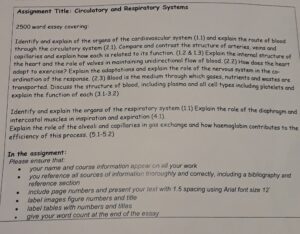

ANSWER
ACCESS TO HEALTH CIRCULATORY AND RESPIRATORY SYSTEM
Cardiovascular and breathing system is two important system of the human body. This study aims to focus on the relationship of the cardiovascular and breathing system. Along with that, it also aims to focus on the different components of blood and their functions. On the other hand, different diseases have effects on the cardiovascular as well as respiratory system of the body.
Cardiovascular system as well as respiratory system both works coordinately in a human body. In the context of the relationship between cardiovascular and breathing system, heart plays a major role. Blood circulation is another major responsibility of heart that plays a major for the transport of the highly oxygenated blood throughout the body (cancerindex.org, 2019). As stated by Sherwood (2015, p.22), blood in the arteries is always remain under huge pressure that has huge effect on the tissues, thus oxygenated blood transfused in the small capillaries of the vessel and then oxygen is transport to tissue. In addition to that, respiratory system is involved in supplying the oxygen to the blood and removing the carbon dioxide from the body. Oxygen from the environment transferred into low oxygen blood through alveoli.
Cardiovascular system possesses three major components such as blood vessel, heart and blood. The pump of the system is heart and vessels act as the delivery routes. Blood is a type of fluid that consists of nutrients and oxygen that are required by the body and transports wastes that are essential to be removed.
Basic structure of cardiovascular system consists of heart, major arteries, and major branches of aorta, major veins and minor vessels. As stated by Paneni et al. (2017), it is the most vital system in the human body that transport not only blood, but also oxygen, hormones blood sugars vitamins, minerals that is produce in one part of the body. Heart mainly composed of muscle and nervous tissue and is divided into four major chambers. It maintains over 100,000 circulations per day for pumping blood over human body parts (cancerindex.org, 2019). In addition to that, the heart contains three layers; Endocardium, Epicardium and Myocardium. It beats over 100,000 times a day to pump the blood around the body cancerindex.org (2019). Blood vessels contain three major parte arteries, capillaries and venules. Another major organ of circulatory system is spleen, which is oval in structure and main function of this organ is to store blood. Blood is the connective tissue that contains erythrocytes, leukocytes and thrombocytes. As stated by Sack et al. (2017, p.197), differetc disease affects cardiovascular system by changing the structures of different organs. Along with that, as this system is linked with the respiratory system, different changes can be also observed in those systems.
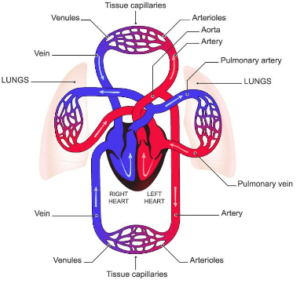
Figure 1: Cardiovascular system
(Source: As influenced by sphweb.bumc.bu.edu, 2019)
Respiratory system is utilized into two significant parts consisting upper respiratory system as well as lower respiratory system (mada.org.il, 2019). Lower respiratory tract consists of the trachea as well as bronchi and bronchioles. Trachea is tube connecting the throat and the bronchi. Along with that, bronchi are utilized in to two different tubes which is connected with the lung. Bronchioli are the smaller branches of bronchi connected with pulmonary artery. Pulmonary artery is connected with the blood capillaries.
Trachea is constructed with the combination of smooth muscle and rings like c-shaped of cartilage which helps in cleansing (mada.org.il, 2019). Trachea is consisting of cilia that are hair like projections on the cells that line the airways. Cilia beat continuously and propel mucus layer that covers the airways. In addition to that, this mucus layer entraps pathogens and related elements as well as obstruct them reach to the lungs. Entrapped particles are coughed out from the body.
In the context of the structure of the Bronchi, it is the main passageway into the lungs and no gas exchanges occurs in this part during inspiration and expiration. Bronchi also moisten and warm the air before it reaches to lung and prevents the tissues from damaging. Bronchioles are meant to keep the irritants and foreign particles out of the airways and effectively control the flow of the air. In addition to these bronchioles produces surfactants and proteins that helps to break down toxins and prevent them from entering the lung. During bronchitis, disorders can be seen in the bronchioles and inflammation occurs. Alveoli plays significant role in exchanging oxygen and carbon dioxide exchange in the respiratory system. Along with that, bronchitis makes breathing more difficult.

Figure 2: Respiratory system
(Source: toxtutor.nlm.nih.gov 2019)
The following discussion highlights the structure of veins, arteries and capillaries.
Arteries are thick hollow tubes which are flexible enough to dilate and constrict. Pulmonary arteries and systematic arteries are the two main types, which carry blood from heart to lungs and deliver blood to the rest parts of the body respectively. Wall of artery consists of Tunica Media, Tunica adventitia and Tunica intima. Structure during Coronary heart disease: the prevalence is higher in the age range of 65-85 (Paneni et al., 2017, p.454). This disease causes the damage of coronary arteries and narrows the blood vessel as plaque builds up (mayoclinic.org, 2019). Along with that, wall of major arteries becomes thicker, stiffer and less flexible (medlineplus.gov, 2019).
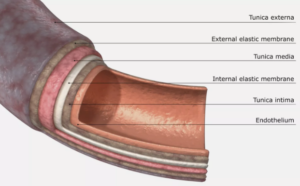
Figure 3: Structure of artery
(Source: toxtutor.nlm.nih.gov 2019)
Capillaries are thin in structure. They connect arterioles with veins. There are main two layers of capillaries such as an outer layer of epithelial cells and an inner layer of endothelial cells. Types of capillaries are continuous, fenestrated and sinusoidal. During coronary heart disease capillary walls become thick (medlineplus.gov, 2019).
Walls of veins are similar to arteries but they are thin. During coronary heart disease veins get blocked and cause higher blood pressure. Two types of veins are pulmonary and systemic, which carries deoxygenated blood from heart to lungs and transports blood from rest of the body to heart respectively.
Arteries carry oxygenated blood from heart. During coronary heart disease as the wall of the arteries became thicker it makes blood pressure higher and also increases pressure on heart. Along with that, this lead to thickening of heart muscle (medlineplus.gov, 2019). This causes a blocked artery and heart failure. The tubing of carrying blood away from the heart is regardless of the oxygenation is provided by the arteries by assisting in pumping of blood.
Capillaries distribute nutrients and oxygen. During coronary heart disease capillaries became weaker and cannot exchange nutrient and water.
Veins provide tubing that helps in taking blood back to heart. They possess thinner wall since they are not required to deal with the constant changes occurring in blood pressure along with the heart contractions. Veins consist of valves that help in preventing flowing of blood in wrong direction.
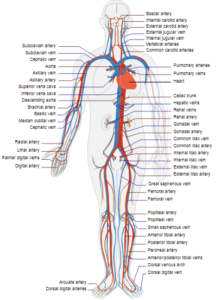
Figure 4: Blood vessel (Circulatory system)
(Source: cancerindex.org 2019)
In the context of circulatory system, heart beats circulates blood through a system of flexible blood vessel. In addition to that, blood delivers type of oxygenate which is coming to the heart from body. Then, through the smaller branches of arteries blood is transported to the small capillaries and then to the tissues. Then deoxygenated blood which contains less oxygen and is rich with waste products are transported through veins to heart.
Heart consists of four chambers divided by tissue wall which is called cardiac septum. Cardiac septum is a muscular tissue that divides the heart into right and left side. Each side of the upper portion of the heart contains atrium and larger lower chamber called ventricles. The right atrium receives poor oxygenated blood from the body and left atrium receives oxygenated blood from the lungs.
Heart consists of four valves that control the blood from the heart when it contracts. Each vales contain leaflets and allows blood flow only one direction. In the context of unidirectional flow of heart, there are two types of valves are present; those are tricuspid valves and mitral valve. Tricuspid valves control the unidirectional blood flow and pulmonary valves play important role in operating the opening position to the pulmonary artery. On the other hand, mitral valve is situated between the left atrium and ventricle and aortic valves controls the opening to aorta.

Figure 5: Structure of Heart
(Source: cancerindex.org, 2019)
During exercise cardiac output increases and increases the heart rates which in turn increase the stroke volume. Along with that, during exercise redistribution of the blood flow also enhance the supply of oxygen to sites of greatest need. In addition to that, heart rate enhances workload till heart rates reaches to maximal level. Improvements in hemoglobin concentrations during exercise are also have been observed. Cardiovascular response to increased demand for oxygen delivery during exercise increases oxygen uptake up to 35 fold during sub maximal exercise (ncbi.nlm.nih.gov, 2019).
The autonomic nervous system plays a crucial role in the context of heart adaptation during exercise. As stated by Fu and Levine (2013, p.42), oxygen uptake is a function of the product of heart rate and stroke volume.
During exercise, stress in the muscle takes place and the brain signals the adrenal glands to produce adrenaline (medlineplus.gov, 2019). Adrenaline helps to increase the rate in which the heart beats. Along with that, it also increases the cardiac outputs. The following discussion highlights the components of blood and reveals each of their roles:
Blood plasma
-
Clear waste cellular function
-
Export waste for catharsis (Rochester.edu, 2019)
Blood cells
-
RBC carries oxygen from lungs to tissues of body
-
WBC plays a major role in immune system (Rochester.edu, 2019)
Platelets
-
Prime role of platelets is related with prevention of bleeding
-
It also plays a significant role in inflammation
-
It also monitor endothelial line to identify break or gap
-
It develops primary homeostatic plug
-
Assist to recover injury (Ouhsc.edu, 2019)
Blood plasma helps to regulate the temperature of the body through release and receive of heat. It also assists to keep the balance of fluid and play an important function regarding immunity. One of the primary functions of plasma is to remove wastes from the cellular functions that assist in the production of energy. This waste is transported from to the various body areas that allows in excretion. (Rochester.edu, 2019)
Blood cells are of two types such as RBC, WBC and platelets. Primary function of the RBC is concerned with the transfer of oxygen from lungs to tissues and clearance of waste of carbon dioxide (Rochester.edu, 2019). RBC helps in transporting oxygen from the lungs to the body tissues and carbon dioxide from the tissues to the lungs. WBC has the function to evaluate leukemia and non neoplastic disease. Platelets help in adhesion and aggregation of blood cells. Being a part of the immune system, WBC helps in fighting infection as well as defends human body against the other foreign materials. Various types of WBC are associated with a number of functions such as recognition of intruders, killing of harmful bacteria as well as creating antibodies. These help in protecting human body against any future exposure to foreign particles, bacteria and viruses.
In the context of breathing in system, after inhalation of the air, two important parts such as muscle of intercostal and contracts related to the diaphragms and expand the chest cavity. Along with that, the diaphragm moves towards the downward and the intercostal muscle move the rib cage upward. The diaphragm separates the chest cavity containing heart and lung from the abdominal cavity and performs breathing in and breathing out process. This increases in size of thoracic cavity and decreases the air pressure within the body. Thus the air from the environment can enters into the lung to equalize the pressure. During breathing out process, the diaphragm and the intercostal muscle return to its previous structure and reduce the size of the chest cavity. Along with that, this change increases the air pressure within the lungs and forcing the air out of the body.
Exchanges between oxygen and carbon dioxide are the significant reason of occurring diffusion between blood and alveoli. Alveoli are a tiny sac that plays a major role during respiration in human body. Oxygen diffuses from the alveoli to the blood during respiration. In addition to that, during this breathing out process, carbon dioxide from the blood reaches to the alveoli. In the context of breathing out process, gradient of concentration has enough impact on oxygen diffusion as well as carbon dioxide into the body (people.eku.edu, 2019). In addition to that, the concentration of oxygen is need to be higher in the alveoli, plays a crucial role in diffusion. During breathing out process, the diaphragm and the intercostal muscle return to its previous structure and reduce the size of the chest cavity. Along with that, this change enhances the pressure of air into the lungs which forces air to leave the body. In addition to that, the surface of the blood capillaries allows oxygen to dissolve. On the other hand thin lining of the alveoli and the blood capillaries allows the oxygen to diffuse into the blood easily. Along with that, hemoglobin of the red blood cells also plays an important role in case of gas exchange. In addition to that, blood which is coming from the heart generally goes to capillaries and collects the oxygen from the alveoli.
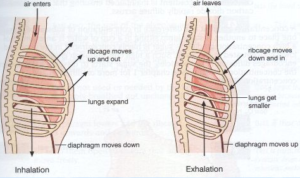
Figure 6: breathing in and breathing out process
(Source: As influenced by people.eku.edu, 2019)
Alveoli’s walls are sealed with thin water film that generates a potential problem during inhalation and exhalation. In addition to that, this creates increased amount of force called surface tension and the water molecule comes closer and the alveoli became smaller. Along with that, pulmonary surfactant decreases the surface tension and reduces the tendency for alveoli to collapse (people.eku.edu, 2019). On the other hand, external respiration can occur efficiently, due to the thin wall of the alveoli and capillaries.
Hemoglobin plays a major role in the body regarding transportation of oxygen. Hemoglobin is a protein present in RBC, which is composed of four different chains. Each of these chains consists of heme which is a compound. This in turn comprises iron that allows transportation of oxygen in human bloodstream. According to the viewpoints of Panawala (2017, p.45), major role of hemoglobin includes carrier of carbon dioxide and oxygen through blood. Along with that it also helps to maintain the shape of the RBC. Along with that, it also plays the role of a buffer. Hemoglobin also interacts with different legions. Hemoglobin binds as well as transports oxygen from lung capillaries to different body tissues. It also allows the transportation of carbon dioxide from different body tissues back to lungs.
From the above study it can be concluded that, coronary heart disease hugely affect the structure of the arteries, capillaries and veins of the blood vessel. Along with that, it also can be concluded that different diseases hugely affect the structures of different organs at various levels. In addition to that, evaluation of breathing in and breathing out process helps to understand the roles of alveoli as well as of hemoglobin in the blood.
Reference List
cancerindex.org (2019), The Cardiovascular System (Heart and blood), Available at: http://www.cancerindex.org/medterm/medtm8.htm [Accessed 05/01/2019]
Dampney, R. A., (2016). Central neural control of the cardiovascular system: current perspectives. Advances in physiology education, 40(3), pp.283-296.
Fu, Q., and Levine, B., (2013), Exercise and the autonomic nervous system, [online], Available at: https://www.researchgate.net/publication/257462016_Exercise_and_the_autonomic_nervous_system [Accessed 06/01/2019]
khanacademy.org (2019), The circulatory system review, Available at: https://www.khanacademy.org/science/high-school-biology/hs-human-body-systems/hs-the-circulatory-and-respiratory-systems/a/hs-the-circulatory-system-review [Accessed 07/01/2019]
kidshealth.org (2019), Lungs and Respiratory System, Available at: https://kidshealth.org/en/parents/lungs.html [Accessed 06/01/2019]
lsa.colorado.edu (2019), The Circulation System, Available at: http://lsa.colorado.edu/essence/texts/lungs.html [Accessed 06/01/2019]
mada.org.il (2019), The Respiratory System – Structure And Function Available at: https://www.mada.org.il/en/about/engineer/challenge/respiratory-system [Accessed 06/01/2019]
mayoclinic.org (2019), Coronary artery disease, Available at: https://www.mayoclinic.org/diseases-conditions/coronary-artery-disease/symptoms-causes/syc-20350613 [Accessed 06/01/2019]
medcell.med.yale.edu (2019), Respiratory System Lab, Available at: http://medcell.med.yale.edu/histology/respiratory_system_lab.php(why there is an extensive system of bronchioles. [Accessed 08/01/2019]
medlineplus.gov (2019), Epinephrine and exercise, Available at: https://medlineplus.gov/ency/anatomyvideos/000051.htm [Accessed 06/01/2019]
ncbi.nlm.nih.gov (2019), Cardiovascular adaptations to exercise and training., Available at: https://www.ncbi.nlm.nih.gov/pubmed/3877552 [Accessed 05/01/2019]
Ouhsc.edu (2019), Platelets on the Web, Available at: https://www.ouhsc.edu/platelets/platelets/platelets%20intro.html [Accessed 08/01/2019]
Panawala, L. 2017. What is the Function of Hemoglobin in the Human Body, PEDIAA, 5(2), 2-7.
Available at: https://www.researchgate.net/publication/313841668_What_is_the_Function_of_Hemoglobin_in_the_Human_Body [Accessed 06/01/2019]
Paneni, F., Cañestro, C. D., Libby, P., Lüscher, T. F., and Camici, G. G., (2017). The aging cardiovascular system: understanding it at the cellular and clinical levels. Journal of the American College of Cardiology, 69(15), pp.1952-1967.
people.eku.edu (2019), Human Physiology, Available at: http://people.eku.edu/ritchisong/301notes6.htm [Accessed 07/01/2019]
Rochester.edu (2019), Health Encyclopedia, Available at: https://www.urmc.rochester.edu/encyclopedia/content.aspx?ContentTypeID=160&ContentID=37 [Accessed 06/01/2019]
Sack, M. N., Fyhrquist, F. Y., Saijonmaa, O. J., Fuster, V., and Kovacic, J. C., (2017). Basic biology of oxidative stress and the cardiovascular system: part 1 of a 3-part series. Journal of the American College of Cardiology, 70(2), pp.196-211.
seer.cancer.gov (2019), Circulatory Pathways, Available at: https://training.seer.cancer.gov/anatomy/cardiovascular/blood/pathways.html [Accessed 06/01/2019]
Sherwood, L. (2015). Human physiology: from cells to systems. Boston: Cengage learning.
sphweb.bumc.bu.edu (2019), Cardiovascular System, Available at: http://sphweb.bumc.bu.edu/otlt/MPH-Modules/PH/PH709_Heart/PH709_Heart2.html [Accessed 07/01/2019]
texasheart.org (2019), Anatomy of the Heart and Cardiovascular System, Available at: https://www.texasheart.org/heart-health/heart-information-center/topics/anatomy-of-the-heart-and-cardiovascular-system/ [Accessed 06/01/2019]
Looking for best Biology Assignment Help. Whatsapp us at +16469488918 or chat with our chat representative showing on lower right corner or order from here. You can also take help from our Live Assignment helper for any exam or live assignment related assistance.